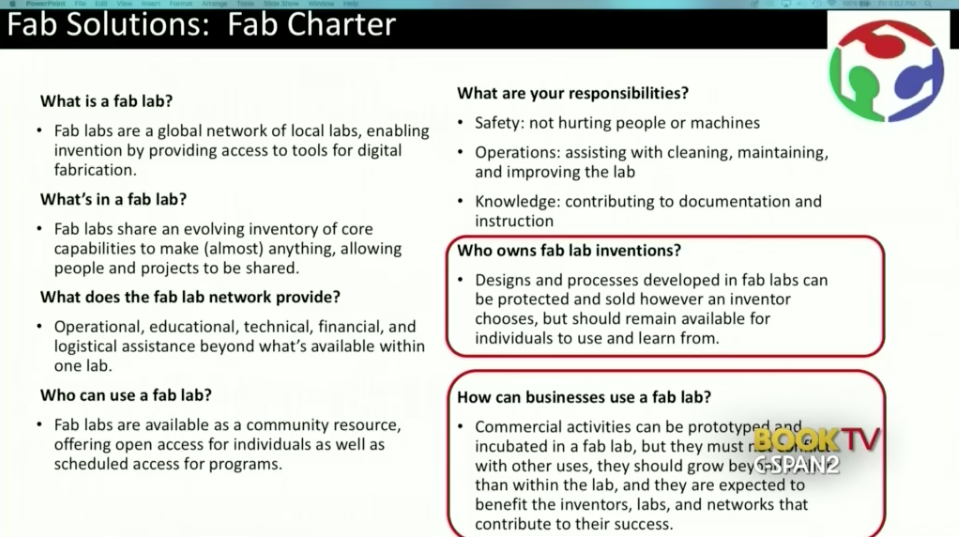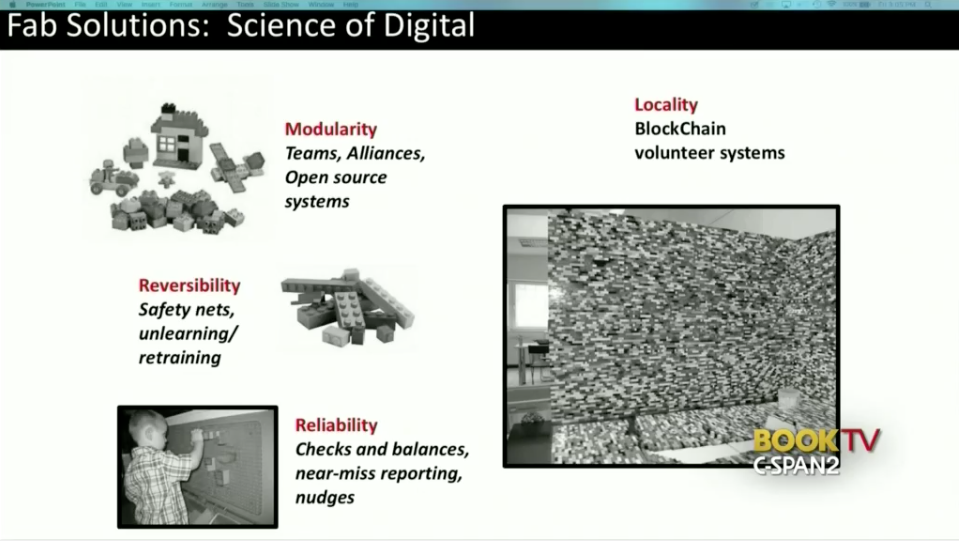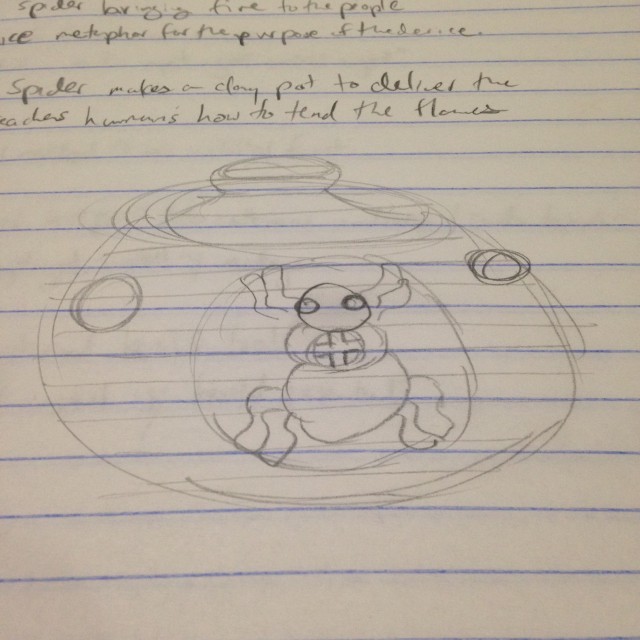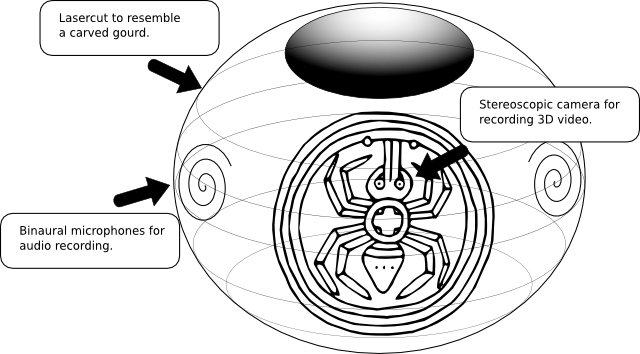Principles and Practices
Have you:
Read the Fab Charter: Designing Reality
How can influence the shape and the ethos surrounding digital fabrication?
Alan Gershenfeld, social impact of media and games
Joel Cutcher-Gershenfeld, large scale systems of change
Fifty year doubling of computation and communications, illustrated by Moore's Law. Parallel scaling experienced in Fab Lab Network, Lass's Law.
Carnegie and spread of public libraries, proliferation of fab labs is analogous through the work of champions like Mel King, Haakon Karlsen, Blair Evans, John Peto, and Phyllis Klein.
Fab Academy was meant to retain talent of extraordinary individuals that were inspired to solve local problems through digital fabrication.
Rep. Bill Foster, the only physicist is Congress, introduced the National Fab Lab Charter. National network is a "cloud" laboratory that empowers and informs solutions on the local level.
Altair is the first personal computer. Empowered innovations by Bill Gates as well as the Homebrew Computer Club. Stephen Wozniak, "Homebrew and How the Apple Came to Be".
Supply chain is deprecated to tens of digital materials that can be assembled by properties.
Question posed by von Neumann, how to make a mahcine that communicates a computation for its own construction?
What are the minimal building blocks that you need to bootstrap a technological civilization?
Joel; the technology is marching at an exponential rate, but what about society?
Alan; disciplines and ideas for businesses tend to overlap.
Joel; domain is Social Science. What is the path? Neither dystopian nor techno-optimism. Both parents were college professors of industrial relations and labor arbitrators. Begins with labor management principles but transitions into large systems. Installation of fab lab takes about a month. Organization of organizations to support a fab lab takes about two years.
Alan; going from Hollywood to video games. Power of video games as a medium was huge. Game for Change, chasing millions of dollars without much impact on the other end of development. Every project is a multistakeholder project. Cook Inlet Tribal Council, how to empower youth and direct their own narrative within the media? CITC is largest stakeholder in e-Line Media. Development of FAB game triggered the installation of a fab lab.
The book starts with a hypothetical time travel episode back into 1965. If you are a policy maker or a social scientist, what are the questions of inclusion? Social sciences were reactive to the science in reality. Today, four billion people still have no access to the Internet. A fab lab can not function as designed without the access. Most of the planet is ill-equipped to reap the benefits of digital fabrication technology.
"The Internet is not a luxury, it is a necessity", Barack Obama. If we look at the next fifty years of FAB, what are the issues of FAB divides and FAB access? Access and literacy are a part of FAB inclusion. Computer acquisition did not match with literacy promotion. Technology sat while literacy attempted to catch up. Fab Labs leverage multiple domains, disciplines, skills, and dispositions.
The process of making things has enormous benefits. We are not however at a point in which we can make what we consume. What is usually overlooked are enabling ecosystems. One of the most important things in the Fab ecosystem is the mentor. People are desperate for mentors. We need a fullbright type of scholarship that can enable a Jens-like journey to cultivate mentors.
Joel; there are about 15 - 20 needed platforms. How to cultivate mentors? How to do equipment repair? How to share designs? Platforms are currently being cobbled together, not so much being implemented on a global scale. How can you anticipate change, align stakeholders, cultivate ecosystems so that social and technical can co-evolve?
Alan; how can we error correct the social along with the technical? Social error correction is much slower, but could be accelerated. How does toxic behavior proliferate? How does positive behavior proliferate? Immediate feedback loops with buy-in from the community on the methodologies. Brendan Maher, "Good Gaming: Scientists are helping to tame toxic behaviour in the world's most popular online game." Social science error correction married with technology.
Government, Philanthropy, Corporate, Distributed; Fab Solutions: inclusion a focus and priority now...
How do we reduce friction for people wanting to join the network? For any system, risk mitigation is a concern. Fab risks include ethics around weapons and biofabrication. If the number of fab labs doubles every year and a half, consumables needed to faciliate become an ecological risk. Fair treatment, succession planning, depend on the existence of a physical work space; what happens when the work space is distributed?
The Fab Charter is way out of date. There is nothing in the charter that governs how big decisions are made.

Fab Labs make us rethink the concept of work. There is potential for a blended economy (i.e., volunteer hours producing work credits). Impact of Moore's Law at Intel is analogous to the boulder scene in raiders of the Lost Ark, work racing innovation at an exponential rate.
What if we think of organizations in modular terms?

Alan; head (logic), heart (human face and emotion), hands (experience and feedback leading to a path forward). When you get invited into something you care about, you fail most of the time but you are getting feedback. The consideration of the three concepts is important to promote a movement centered around FAB inclusion.
Alex McDowell and Alan started a new company, design shop, towards aspirational but achievable futures. Experimental Design, Rapidly-Prototyping the Future
Alan; study on Minecraft, Linux, Wikipedia, etc.: Galvanizing vision -> Offer (accessible) platforms and tools that people can modify and extend -> Users that can adopt and adapt platforms and tools
Core controversy; what are the definitions of Propagation and Scale?
Sketch a design idea on paper and in the computer
For a few generations, my family has served as keepers of the ways of my tribe. We hold our story and song tradition close. Over the past year, I have participated in a couple conferences to gain insight on the role of technology in language and culture preservation. Background
There is a wealth of classic media that exists documenting tribal culture, both oral and material. Much of the resources require efficient digitization and curation. These resources serve to inform language and culture preservation and revitalization initiatives.
Costs of object-centric digitization, analysis and curation can be prohibitive. At The University of British Columbia, the Irving K. Barber Learning Centre hosts a collaborative project known as "Indigitization." The project seeks to clarify processes and identify issues in the conservation and digitization of First Nation community information resources.
I learned about Indigitization by attending the annual meeting of the American Anthropological Association. During that meeting, I learned of the Indigitzation Toolkit. Similar to Fab Lab technology, the toolkit supports community efforts at digitization taking analog communication (language and texts) and curating it as bits.
Access to curated information presents another challenge for community preservationists. Instead of a publicly open and accessible system, proper consideration must be given with respect to community set guidelines. Some information can be deemed sensitive based on age, gender, and whether or not the person accessing is a community member.

I chose the form of a brief case in reference to Pop Fab, designed by Ilan Moyer and Nadya Peek. I want to create a portable device for digitization and curation. I chose the name Indigi-Case to be descriptive and allude to the fact that I base the proposal on the Indigization toolkit.
The case itself is a cross between a netbook and a Nintendo 3DS. It features a cassette deck “drive” for digitzation of classic media. I added two jacks for headphones and speakers. Two usb ports for devices. I plan to embed a keyboard in one side of the case. Facing opposite, is an LCD screen with two internal speakers. Above the screen is an internal camera. On the outside of the case, I have a stereoscopic camera for 3D pictures and video of material culture or subjects/informants.

After some thought, I decided to go with a different design that was based on pottery that was more culturally expressive of my own Tribe. I based my design off the Mississippian spider motif which is representative of Choctaw stories of how Grandmother Spider brought fire to the people.

I roughed out the design in Inkscape for further features. I still want to build a "language lab in a box" as previously conceived.
2018 Class Notes
What is Digital Fabrication
There are three digital revolutions. Phones used to degrade with distance. Now we use the Internet to talk. Computers used to degrade with time.
Moore's Law, "Cramming more components onto integrated circuits". Concept of doubling scale. From components and transistors to "Lass' Law" which plots the doubling of fab labs within the International Fab Lab Network.
Connecting computers to machines was invented at MIT in 1952. The Whirlwind was the first real time computer. Around that time, jet aircraft were emerging. The parts were too hard to make by hand. The idea was that a real time computer could be connected to a machine to "turn the crank".
Vannevar Bush, he made the first analog computer at MIT. Claude Shannon was frustrated with using a computer that accumulated errors over time. "A Symbolic Analysis of Relay and Switching Circuits" proves that Boolean algebra could be used to simplify the arrangement of relays used for communication. Shannon's work was applied by von Neumann to computation. Digital is a scaling property. By using a symbol representing the linear increase in the use of resources, whether in computation or communication; the error rate drops exponentially.
Digital fabrication was "invented" four billion years ago. Humans are constructed from 20 amino acids which work like molecular Lego. Amino acids have properties. Ribosomes are assemblers that bolt together amino acids. Human bodies are then constructed "digitally".
On the surface level, digital fabrication is using a computer and a tool to make something. The deeper meaning is creating the code to make the thing.
MIT's Center for Bits and Atoms facilitates a ten million dollar "fab lab", which is a suite of research tools. There was a bottle neck on instruction of how to use the tools. This lead to the creation of "How to Make (almost) Anything". Projects from this class answered not so much "how" but "why" to do digital fabrication.
Following the parallel of development of computation, the Whirlwind was transistorized into the MIT TX-0 computer. TX-0 was commercialized into the PDP. The birth of modern computing happened at Bell Labs with the PDP, this was reflected in a scaling down physically of equipment from a building scale to a room. Ken Olsen was skeptical about the personal computer stating, "There is no reason for any individual to have a computer in his home". The killer app for computing ultimately became personal computing. The parallel discovered in the HTMaA class was that digital fabrication could be used to make products for a market of one, personal fabrication.
Educational outreach from CBA lead to the Fab Lab programming. The community-based Fab Lab is analogous to the PDP in scale. Filling the room, it is one machine or system for digital fabrication. One machine cannot make almost anything. The collection of fab lab machine can rather output any such projects.
Need to follow up: Haakon, nomadic herding and land use applications.
The International Fab Lab Network is part of the broader Maker movement. It is a more curated facet of the movement. No one is pushing populations to build fab labs, the labs are pulled into remarkable settings around the world.
Fab Academy is distributed education, distinct from learning at the institution or online instruction. Participating Fab Lab nodes are an extension of the campus. A number of the class projects become businesses all came out of homework assignments in the Fab Academy.
How to Grow (alomost) Anything came from a collaboration with George Church.
Fabricademy is digital fabrication meeting textiles.
MIT is a mainframe. Online classes are still centrally facilitated from a mainframe. Fab Academy is a distributed educational network. It is not so much controlled centrally.
Seymour Papert, fab labs lead to the literacy of not just how to use technology, but how to also build technology.
Fab Labs in Barcelona, fab labs could be used to start a business. Fab labs can also be used to make what people consume. The connection is open globally for knowledge. The atoms, matter stays within Barcelona for production. Fab Cities initiative is about local governments pledging to take on self-sufficiency. This does not lead to the creation of traditional jobs, but it does empower consumers to produce what they consume.
Personal manufacturing will ultimately replace traditional manufacturing.
Global Humanitarian Lab; instead of managing relief by physically sending solutions, the global network could send data and solutions could be manufactured locally.
FABx events; 11 was when the network descended upon MIT. FAB12 took the event to Shenzhen, China. Mass manufacturing plays a role in producing tools needed to create solutions locally.
Fab Foundation manages capacity. FabLabs.io is a social network for fab labs. If anybody can make anything, anywhere; what are the organizations to help manage that ability? Similar to ICANN and sister organizations on Internet Architecture Board.
Scale; we are now going from 1,000 to 1,000,000 fab labs. One million is the number of towns in the world. To go from one point of scale to another, How to Make Something That Makes (almost) Anything was developed. Modular software and modular hardware helps to rapidly make machines. Nadya Peek, "Making Machines that Make: Object-Oriented Hardware Meets Object-Oriented Software". Jens Dyvik built upon the work of modular machines. The idea is to make a machine that would be capable of making its own parts. The next step of fab labs is to be able to composed and design parts for machines that make.
From one million to one billion; this is the number of people on Earth. The supply chain needs to be deprecated. How can materials be digitized?
From one billion to one trillion, this is the Internet of Things but for a manufacturing application. Ribosomes are slow they make complex structures at one molecule per second. Ribosomes also construct other ribosomes. Hierarchy in biology is parallel in engineering. Blending communication and computation for fabrication output. John von Neumann, "Theory of Self-Reproducing Automata".
Manufacturing is going from a mainframe to a minicomputer (fab lab) to a personal computer (mtm) to ubiquitous (Star Trek Replicator). Research to reach ubiquitous takes fifty years, we are currently in the middle of that path, the "mini computer" era. The class is teaching digital fabrication, but also asks what is: business, education, governance, and how does the world change?